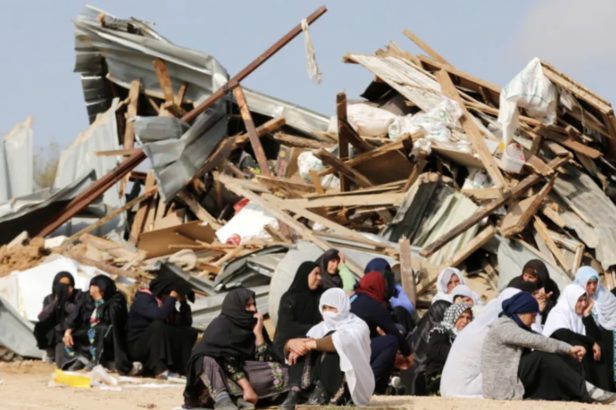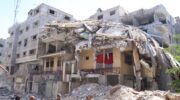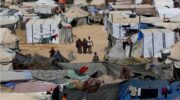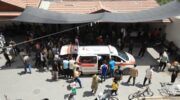In Part Three of the in-depth article from the Intercept on Israel’s decades-long campaign to rid the land of Palestinians, read about the current situation under Israel’s extremist government, and Israel’s ruthless efforts to evict Palestinian Bedouin inside Israel from their historic land and lifestyle. (Read Parts One and Two here and here; watch for Part Four.)
by Alice Speri, reposted from The Intercept, April 1, 2023
While apartheid policies encompass a range of institutionalized discrimination practices — from restrictions on residency for non-Jews to the recent introduction of legislation that would seek the death penalty for Palestinians only — the element of racial domination that is intrinsic to the concept is particularly evident in Israeli land policies.
“They want maximum land with minimum Palestinians,” said Ori Givati, advocacy director at Breaking the Silence, a group of Israeli veterans opposed to the occupation. “They don’t want to annex tens of thousands of Palestinians because eventually they’ll have to give them citizenship.”
Givati, who served in the military in the West Bank, described a close collaboration between the state — through the military — and the ideological settlers driving the land grab in the West Bank. The two regularly worked together, he said, with representatives of the settlement movement often participating in military drills and speaking to soldiers sent to serve in the territory.
“Basically we’re seeing a system which deprives Palestinians of their lands and aims to push them away from living in Area A, into Areas C and B,” he added, during a visit to the South Hebron Hills. “And that element of using settlements in order to divide the land is very visible here.”
In many ways Masafer Yatta is a microcosm where the dynamics playing out across the entire West Bank are magnified by the designation of the firing zone. Daily harassment of Palestinians, illegal settlement expansion, and settler violence have been growing steadily throughout the occupied territory for years. So has the number of Palestinians killed by Israeli forces — which last year reached the highest toll since the end of the Second Intifada in the early 2000s.
Getting worse
So far, 2023 has been even worse, with Israeli raids in cities like Nablus and Jenin killing dozens, and settlers setting fire to homes and cars in a series of attacks that have been compared to “pogroms” and that were encouraged by top officials of Israel’s new fundamentalist government.
The extremism of the current Israeli government has in many ways laid bare the reality of Israel’s project of domination. As settler violence in the West Bank has reached historic records in recent months, Finance Minister Bezalel Smotrich recently called for a Palestinian village attacked by settlers to be “wiped out,” before being forced to apologize.
And as protests in Israel reached a peak this week, National Security Minister Itamar Ben-Gvir, a settler once convicted of supporting an Israeli terrorist organization, worked out a deal with Netanyahu to delay the controversial judicial reforms in exchange for the establishment of a new security force that will operate under Ben-Gvir’s direct orders — a prospect that some have likened to handing the extremist minister a “private militia.”
But before the likes of Smotrich and Ben-Gvir reached the highest level of the Israeli government, the groundwork for the supremacist project they have championed had been in motion for years, advanced under more liberal Israeli governments as well — much of it unfolding with at best tepid criticism from Israel’s closest allies, including the U.S.

Across the Green Line
While Israel’s expropriation of Palestinian land is most visible in Area C of the West Bank, it is a reality also in Jerusalem, as well as inside Israel, defined as the territory of Israel before the 1967 occupation of the West Bank and east Jerusalem, even though Israel’s borders remain an unsettled matter.
There, like in the occupied territories, an array of laws and legal justifications have resulted in the seizure of much of the land belonging to Palestinians who became citizens of Israel after an estimated 750,000 others were made refugees during the 1948 establishment of the state. Today, there are approximately 1.6 million Palestinians with Israeli citizenship, comprising more than 20 percent of Israel’s population.
Eghbariah, the human rights attorney and a Palestinian citizen of Israel, argued a particularly effective tool deployed by Israel has been the legal fragmentation of Palestinians themselves into different categories, with different IDs, rights, and legal frameworks applying to each. “It’s a regime of legal fragmentation that classifies some Palestinians as citizens, and some as residents of the West Bank, or Gaza, and some as residents of Jerusalem, and each of them have different legal statuses,” he told me. “It designs different tools to experiment. It’s labs of oppression and domination.”
Land grabs inside Israel are often overlooked, Eghbariah added. But there too “is dispossession, there is segregation in the ways that accessibility to resources and land is distributed,” he said.
Since 1948, for instance, officials have authorized the creation of more than 900 “Jewish localities” inside Israel, but have only granted a handful of permits for government-planned townships for Palestinians. Most of those are communities the Israeli state has created for Bedouins that it continues to displace across the Negev desert — even as those Bedouins have for years resisted forced relocation to these poverty-stricken townships.
Bedouins endangered
In the Negev, the historical land of the Bedouins dating back centuries, Israel has announced plans to forcibly displace 36,000 people living in roughly 40 “unrecognized” communities, in order to expand military training areas and implement what it called “economic development” projects.
In total, some 90,000 people live in unrecognized Bedouin communities in the desert, and also face an uncertain future. Adalah, an Israel-based human rights group, has been representing many of the Bedouin communities facing eviction as they fight in court for the right to stay on their land.
“The plan provides clear confirmation that Israel’s Authority for the Development and Settlement of the Bedouins in the Negev overtly discriminates against the Bedouin population,” the group wrote, referring to the government agency set up to handle Bedouin affairs — which Bedouins view as the agency tasked with their oppression.
The agency, according to Adalah, views Bedouins “as an obstacle that must be removed from the landscape in order to clear a path for Jewish settlement and ‘development’.”
That dynamic is not unlike that unfolding in Masafer Yatta, even as the Bedouins targeted for displacement are Israeli citizens. For those Bedouins, who over the decades have watched the desert become urbanized and threaten their way of life, the eviction orders are a bitter irony.
“They call us invaders, they say we are trespassers in this land,” Freij Al-Hawashleh, an 86-year-old Bedouin man, told me when I visited his community, Ras Jrabah, on the outskirts of the industrial city of Dimona.
Al-Hawashleh remembers when the area was under the control of the British Mandate, before the establishment of the state of Israel. One day, after 1948, some officials came to hand the members of his community blue ID cards: their Israeli citizenship. The Bedouins stayed on their land and continued growing their crops.
Then, in the early 1950s, came the first settlers; Al-Hawashleh said that the Bedouins shared water and milk with them when they arrived. “Dimona was established on our land,” he added.

Resisting removal
Today, Dimona is a rapidly expanding city, with construction projects underway on multiple sides. A campaign launched under the previous Israeli government offers an array of benefits to convince Jewish Israelis to move here. On the city’s main thoroughfare, a monument nods to the roots of the city: a mural with the figure of a man in Bedouin dress walking camels across a desert landscape. But that’s as far as Dimona’s recognition of its Bedouin residents will go.
Al-Hawashleh’s community is one of the unrecognized Bedouin villages under eviction orders. The government wants its residents to move to Gasir as-Sirr, one of the townships it has designated for Bedouins, five miles away.
When that proposal was announced, the Bedouins petitioned to stay in Dimona and presented a plan to establish their own recognized neighborhood there — but they were denied and told they could only move to towns specifically created for them.
For now, as construction has continued in the city, the Bedouins have stayed put. Feet away from their homes, the municipality has built a large new playground for Dimona’s children, but the dozens of children living in the Bedouin village only play there late in the evenings, if nobody else is there, adhering to an unwritten rule that they are not wanted there. Still, members of the community have no plans to leave.
“If they want me to move, they can take a gun and shoot me,” said Al-Hawashleh. “I will sit here and never move.”
The Israeli government has shrouded its policy of displacement in the language of modernization and the promise of better services. But the towns Bedouins are moved to are among Israel’s most impoverished and with poorest access to resources, with some of the country’s worst unemployment and crime rates.
Bedouin face demolition, camel confiscation
“The government always tries to tell the Bedouins, ‘If you want services, you need to move. If you want water, you need to move,’” Marwan Abu Frieh, a coordinator with Adalah, told me. “When that doesn’t work, they try to move them by force, by demolition orders.”
Home demolitions, he noted, are becoming increasingly common inside Israel. And as in the West Bank and east Jerusalem, Israel often forces those facing demolition orders to destroy their own homes themselves — or face hefty fines to cover the cost of the bulldozers.
“The same things that are happening in the West Bank are happening here,” Abu Frieh added, noting that the practice has deeply traumatized the Bedouin population. “The same apartheid that’s there, is here.”
Al-Bqea’ah, another of the unrecognized communities facing eviction, stands against the backdrop of Masada, one of Israel’s most iconic tourist attractions, but the state is seeking to forcibly relocate its residents to the township of Mar’it, some 20 miles away.
Next to Al-Bqea’ah, an Israeli-run tourist village offers visitors rides and photos with camels. But while camels have been a part of Bedouins’ lives for centuries, it has become increasingly difficult for them to keep them, as officials have refused to recognize camels as farm animals and have denied their owners grazing rights on lands where they traditionally kept them.
Officials regularly confiscate camels “trespassing” into areas declared off-limits — sometimes lifting them with cranes to transport them away. They then charge exorbitant fees to return them to their owners.
The government’s resettlement plan — in addition to having been established without consulting the Bedouins — is fundamentally at odds with their traditional lifestyle.
“You can’t take a Bedouin from the desert and move him to a town; the Bedouins need freedom,” Moussa Al-Hawamsha, an elderly resident of Al-Bqea’ah, told me. His family has been living there since 1953, when they were moved there by Israeli authorities who evicted them from their original lands near Dimona, to make room for an industrial zone.
When a Jewish man came in the 1980s to set up the tourist village next door, Al-Hawamsha said, they gave him camels and helped him get established; many residents of the village still work at the tourist site. At times, they helped authorities search for hikers lost in the desert, which they know intimately.
“Now, he has a permit to stay, and we are in court,” Al-Hawamsha added, stressing that Al-Bqea’ah’s residents do not want to leave. “If they want to move us again, they should move us back to the land we came from.”
(Stay tuned for Part 4 of this Intercept article; read Parts 1 and 2 here and here.)
RELATED READING ON PALESTINIAN BEDOUIN:
- Cleansing the Negev: Israel plans to evict “tens of thousands” of Palestinian Bedouin
- Ten Days, Five Israeli Bullets, Five Bedouin With Serious Head Injuries
- 1951 Documents Reveal Israel’s Intent to Ethnically Cleanse Bedouin from their Lands
- Israel to demolish home of 95-year-old disabled Palestinian woman in Negev
- Palestinian senior citizen dies after hit-and-run by Israeli police
VIDEOS:





